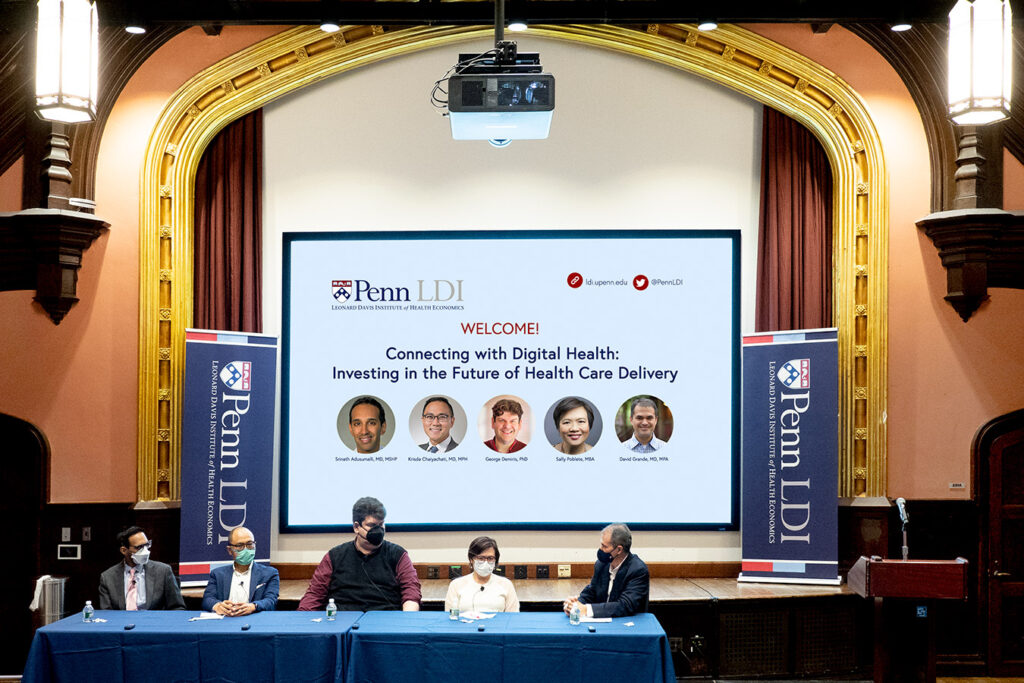
Integrated Care Plans Didn’t Boost Medicaid Enrollment for the Poorest Seniors
Chart of the Day: Medicare-Medicaid Plans—Created to Streamline Care for Dually Eligible Individuals—Failed to Increase Medicaid Participation in High-Poverty Communities
News

Supercharged by the last two years of pandemic emergency, the adoption and use of new digital technologies in health care delivery has escalated at breakneck speed and been widely hailed as a success in the general press. But, according to the expert participants in a University of Pennsylvania May 13 panel, the same trend is raising profound questions and daunting challenges as these digital products, systems, and methods continue to proliferate as an obviously permanent and revolutionary reality impacting nearly all future aspects of health care.
Convened by Penn’s Leonard Davis Institute of Health Economics (LDI), the panel event entitled “Connecting with Digital Health: Investing in the Future of Health Care Delivery,” explored both the potential new opportunities created by these technologies’ rapid penetration of the clinical space and the less understood challenges and dilemmas that same technology is forcing health systems to confront.
Adopted expediently during a national health emergency, large numbers of these digital technologies and processes were taken up on the fly without anchors to traditional research evidence about their clinical efficacy or the best practices for their use.
Beyond that thin evidence, other digital tool issues now coming to the fore within provider organizations include implications for health equity, lack of interoperability, unprecedented levels of information overload, clinical uncertainty about which digital tools to use in what patient situations and why, and implementation standards for integrating digital tools into routine clinical operations and electronic health records systems.
The four panelists included Srinath Adusumalli, MD, MSHP, LDI Senior Fellow and the Assistant Chief Medical Information Office of the Penn Health System and Director of Informatics at the Penn Center for Health Care Improvement and Patient Safety; Krisda Chaiyachati, MD, MPH, LDI Adjunct Senior Fellow and the former Medical Director of Penn Medicine OnDemand Virtual Care who recently became the Physician Lead for Value-Based Care and Innovation at Verily Health Platforms, formerly known as Google Life Sciences; George Demiris, PhD, FACMI, LDI Senior Fellow and Professor of Biobehavioral Health Sciences at Penn Nursing and Epidemiology and Informatics at the Perelman School of Medicine who is a specialist in robotic devices designed for care in home and assisted living facilities; Sally Poblete, MBA, Vice President of Circulo Health, a health insurance technology company; and moderator David Grande, MD, MPA, Director of Policy at LDI.
The discussion opened on the question of what important points have been learned about digital health technology during the pandemic.
“One of the most important things demonstrated so far,” said Poblete, “is that technologies like telehealth can multiply human clinicians’ efforts and exponentially increase access to care at a time when there are insufficient numbers of doctors, nurses, therapists, home health aides, and caregivers to handle the load. For instance, the pandemic emergency response through digital means has provided insights into how we might more effectively address the rapidly growing care needs of the aging baby boomer population.”

“Throughout Penn Medicine and from other colleagues around the country,” said Adusumalli, “I think we’ve learned the multiple opportunities the pandemic has presented that enabled us to put all the “plumbing” — digital technologies and processes — in place that are needed to support digital health tools. A lot of them didn’t exist in any scalable way. Prior to the pandemic Penn Medicine had isolated pockets involved in digital health tools but not to any degree of scale. Just prior to the pandemic’s arrival in March 2020, we were doing 300-to-500 virtual medical visits (telemedicine) a month. Two months later, we went to as many as 8,500 virtual visits in a single day. That was a lot to achieve, and it taught us a lot about changing the internal culture of organizations to enable risk-taking in the digital space and being able to adopt digital tools on such a scale.”
Another challenge presented by digital health is its success in facilitating web portals, apps and devices that provide instant and direct patient-clinician communications. The industry maxim that “if you build it, they will come,” turned out to be wildly accurate for these services. Add to that the constant streams of incoming data from various kinds of in-house and remote monitors and you have a dramatically different kind of clinical environment.
“I can tell you the information coming towards us as primary care physicians is like a firehose of stuff,” said Chaiyachati. “It’s not just the communications with our patients, but the technology advances elsewhere as well. New things are happening so quickly and we’re constantly trying to adapt to all the ways in which medicine is changing and the ways in which our patients interact with us. While I see that as a challenge, I think it’s also an incredible opportunity for us to develop some efficiencies on the care delivery side.”

“We need to be asking how we can interface with our patients, our care teams, and our providers in ways that make it easy to care for patients while at the same time allowing those communication channels to continue to happen in a very streamlined way, Chaiyachati said. “I think that’s one of the biggest challenges ahead of us.”
Beyond the clinical space, digital tools are being heavily woven into efforts to find more effective ways to keep frail older adults safer in their homes and their remote care teams more engaged with preventive information gathering and response.
Demiris designs and evaluates “smart home” systems that use telemedicine techniques along with remote digital bio-metric monitoring, motion and behavioral sensing, and appliance-specific detectors to keep frail older adults safer in their homes.

“We have learned there are great potential benefits to using digital tools to promote a more proactive model in homes and residential care facilities,” said Demiris. “The idea is to prevent adverse events before they occur. If we prevent the fall, we prevent the hospitalization. There are many clinical, ethical, and practical challenges involved in making these components talk to each other to create a coherent system out of all that.”
“COVID has made it pretty clear that we have to also think more about how these technologies can be made inclusive,” Demiris continued. “When we switch to telehealth, we realize that a portion of the population may not have broadband access, or they may not have experience with technology, or they may have functional hearing or visual limitations and not be able to take advantage of these systems. As we watch the pervasive diffusion of digital tools, we want to make sure we don’t create solutions that actually exacerbate the existing inequities.”
As health systems scale up and add multiple new digital tools to their therapeutic inventory, it raises another kind of quandary for clinicians: How to decide if the care should be in-person or virtual and, if virtual, which variety of virtual?

“In terms of the general science, we are still in the ‘accelerated learning’ phase on that,” said Adusumalli. “We do see particular spaces emerging that are more amenable to virtual care. At Penn, our behavioral health presence is using virtual visits in about 80% of care. In cardiology, I think our practices are still at 20%. There are a lot of open questions: What are the right clinical settings? What are the outcomes we’re measuring? What is the framework for how we assess quality and safety within the context of telemedical care delivery?” Right now, there are large gaps that need to be filled in terms of what tools fit in the right clinical context for the right patients at the right time.”
Chaiyachati agreed. “It has become a much more complicated question about how do we deliver that care rather than what’s the right form of care that needs to be delivered.”
Poblete pointed out another dimension of that same quandary: what the patients actually want.
“We have a brand new primary care operation in upstate New York and we’re very curious about what our members are going to prefer now that they have the virtual option,” Poblete said. “We’re experimenting by asking their preference — would they like to interact with us virtually (assuming there’s not a physical exam or procedure that needs to be done) or do they want to see us in-person on-location? It’s still early, but so far, they are wanting to come to us in-person.”
“And this not just a yes or no issue,” Poblete continued. “There’s a lot of nuance. From a cultural standpoint, there’s evidence that Black and Hispanic patients are less likely to use telehealth video because of concerns about privacy, or comfort, or English not being their first language. They are more likely to use audio visits. I highlight this because we have to be more deliberate about making sure that everyone has equal access to these technologies.”
All panelists concurred that information overload, uncertainties about clinical virtual care decisions, and the lack of evidence-based research across so much of digital health underscore the need to move toward industry-wide system integration.
“How do we start that move?,” asked moderator Grande. “Is it on the payer side or delivery side? Who drives that system integration and actually begins moving toward bringing these digital tools together in a more meaningful way?”

Adusumalli: “The first step would be interoperability. How do we get those different digital tools talking to each other and ultimately to you as a patient? It doesn’t matter what we’re using on our end. It should be one cohesive experience across clinicians, across care settings and also across disease processes as well. That’s actively a problem that we’re working on right now. On the clinician end, I think a lot of digital tools are being developed outside of the clinician workflow. And right now, and for the foreseeable future, that workflow is based within the electronic health record.”
Poblete: “It makes sense to start from a very focused solution for cardiology or some other specific so that the technology, the science, and the data could really be laser focused on that particular problem or condition. One way to think about a systems view is starting all development with open standards of data interoperability so that whatever data is collected from any of these devices or systems are widely shared with electronic health records and health information exchanges so that aggregation can occur.”
Chaiyachati: “I think that we will transform from these one-off disease specific approaches and start to see a merger of all these things into one coherent system. It’s obviously easier done on a provider organization level, like in medicine. It would be easier but challenging for the payer side to view it from the big picture. I think digital companies and big technology companies — I work for one now — must think about this as the development of a larger integrated ecosystem.”


Chart of the Day: Medicare-Medicaid Plans—Created to Streamline Care for Dually Eligible Individuals—Failed to Increase Medicaid Participation in High-Poverty Communities
Research Brief: Shorter Stays in Skilled Nursing Facilities and Less Home Health Didn’t Lead to Worse Outcomes, Pointing to Opportunities for Traditional Medicare

How Threatened Reproductive Rights Pushed More Pennsylvanians Toward Sterilization

Abortion Restrictions Can Backfire, Pushing Families to End Pregnancies

They Reduce Coverage, Not Costs, History Shows. Smarter Incentives Would Encourage the Private Sector
Research Brief: Less Than 1% of Clinical Practices Provide 80% of Outpatient Services for Dually Eligible Individuals